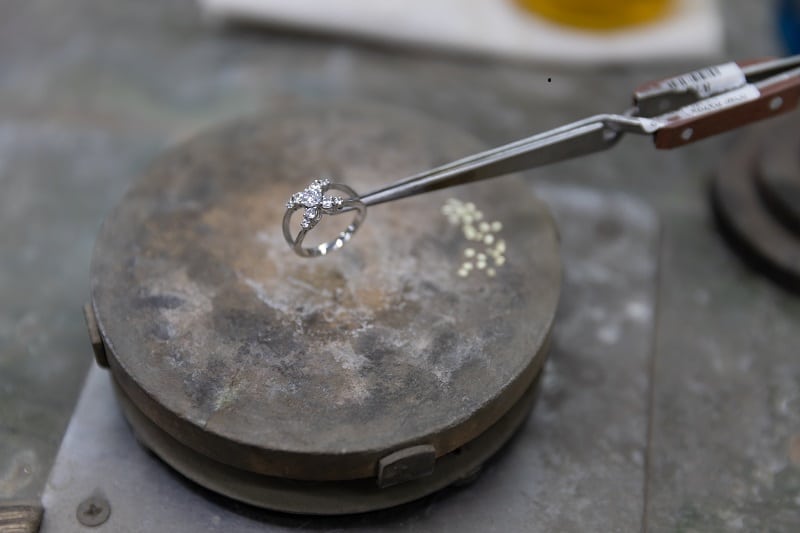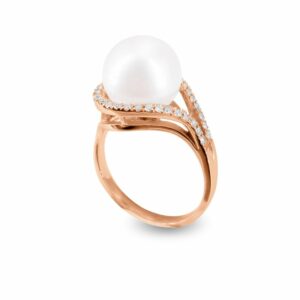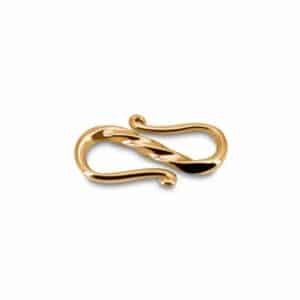Given their balance of durability, affordability, and aesthetic appeal, white gold jewelry findings are an excellent choice for those looking to create timeless, elegant jewelry pieces
In the vast landscape of ornate adornments and valuable metals, white gold exudes a distinctive allure that captivates artisans and wearers alike. In this comprehensive article, you’ll learn everything you need to know about “White Gold Jewelry Findings.” We will unfold the intricate process of creating this precious alloy, revealing the combination of strength and sophistication that defines it.
From functional clasps to fine filigree, this article takes a deep dive into the creation and use of white gold in jewelry findings.
In tandem, we will explore the numerous benefits and occasional drawbacks associated with white gold, providing a balanced perspective. Discover valuable insights to fully appreciate the charm and durability of white gold jewelry findings. Furthermore, learn about the maintenance and preservation of these timeless adornments. It is clear from this article why white gold has earned its place in the realm of jewelry findings.
Gold Purity and Alloys
The richness and value of gold is quantified in karats (K), a measurement system that signifies the amount of pure gold present within an alloy. In this system, 24K gold represents pure, unalloyed gold. While this form of gold exudes an enchanting, rich yellow hue, it’s also extremely soft – a characteristic that can be more of a liability than an asset, particularly when it comes to crafting durable jewelry findings.
For practical applications, such as the creation of rings, clasps, and other jewelry components, pure gold is often mixed with other metals to augment its hardness and durability. This process of mixing metals, known as alloying, fundamentally transforms the nature of gold, lending it increased strength and resilience.
White gold, a dazzling and well-regarded alternative to traditional yellow gold and the more expensive platinum, is one such alloy. This luxurious material is crafted by skillfully blending gold with other white metals, such as palladium or nickel. The unique interplay between these metals culminates in white gold, a material that seamlessly unites the opulence of gold with the strength and durability of its alloying elements. This potent combination imparts white gold with its signature silvery-white sheen, a quality that is highly valued and cherished in white gold jewelry findings.
White Gold Jewelry Findings Production Process
The production process of white gold jewelry findings is a fine art in itself, requiring a precise balance between the constituent metals. A typical white gold alloy is composed of pure gold and a white metal, most often palladium or nickel. The proportion of these metals significantly influences the characteristics of the resulting alloy, with the final composition aiming to produce a strong, yet beautifully polished, silvery material.
This meticulously crafted alloy is then shaped and refined to create a diverse range of white gold jewelry findings. Each of these pieces, whether they’re tiny clasps or elaborate necklace chains, carry the distinctive elegance of white gold. They’re not only durable and functional, but they also add a touch of luxury and sophistication to any jewelry piece they’re part of, highlighting why white gold continues to be a popular choice in the realm of jewelry findings.
The Making of White Gold
The creation of white gold for jewelry findings is a meticulous process. It involves blending pure gold with certain white metals, typically palladium, nickel, or silver. The ratio of these metals affects the resulting color and durability of the white gold. A higher proportion of gold will lead to a yellowish tinge, while a higher proportion of the white metal gives a whiter finish. However, despite this blending, white gold jewelry findings often have a faint yellow hue.
To achieve a pristine white color, white gold jewelry findings often undergo a final treatment: rhodium plating. Rhodium, a member of the platinum family, is used to plate the white gold, giving it a reflective white surface that consumers adore. Over time and with wear, this coating may wear off, revealing the original color of the white gold alloy. The rhodium plating can be reapplied by a jeweler to restore the jewelry finding’s sparkling white finish.
The journey of white gold from raw elements to shiny white gold jewelry findings is a blend of science and art, requiring both technical knowledge and artisanal skill. This process, coupled with the timeless appeal of white gold, adds to the value of white gold jewelry findings in the eyes of both jewelers and consumers.
The Role of White Gold in Jewelry Findings
In the world of jewelry-making, findings are an integral part, encompassing all the small components and materials that combine to create a complete piece of jewelry. This includes a diverse range of elements, such as clasps, links, pins, ear wires, jump rings, and bead caps. Among these, white gold jewelry findings are considered critical components of many ornamental creations, fulfilling both aesthetic and functional roles.
Imbued with an exquisite luster, the superior malleability that allows intricate shaping, and the requisite durability that ensures longevity, white gold is the ideal choice for a wide range of jewelry findings. In fact, white gold jewelry findings offer more than mere functional value. They exude an inherent elegance, elevating the overall design aesthetic of any jewelry piece they are incorporated into. The detailed intricacies of filigree work, the delicate yet robust bead settings – every component stands as a testament to the beauty and strength that white gold brings to the table.
Consider a necklace, meticulously crafted with a white gold pendant and chain. The white gold clasp serves a dual purpose here. Functionally, it secures the necklace around the wearer’s neck. Aesthetically, it seamlessly blends with the necklace’s design, enhancing the luxury appeal of the piece. This duality exemplifies the versatility and adaptability of white gold in jewelry findings, underlining why it is such a preferred choice in the industry.
Significant Advantages of Utilizing White Gold in Jewelry Findings
The utilization of white gold in jewelry findings is not just a matter of aesthetic preference, but it’s also a strategic choice informed by a multitude of advantages this precious metal provides. As such, white gold has become a favored selection among jewelers and enthusiasts alike.
Incredible Durability:
One of the most compelling advantages of white gold lies in its remarkable durability. This metal shows high resistance to wear and tear, making it an ideal material for crafting items that undergo frequent handling, such as clasps, pins, and rings. Its robustness ensures that these pieces maintain their integrity and function over time, significantly enhancing the longevity of the finished jewelry.
Aesthetic Appeal:
Beyond its functional benefits, white gold’s incorporation into jewelry findings contributes substantially to their aesthetic appeal. Its ability to withstand tarnish and corrosion ensures that the jewelry maintains its original, pristine appearance over time, further enhancing its desirability.
Contemporary and Versatile Look:
White gold jewelry findings exude a modern, sleek look that seamlessly complements both modern and vintage designs. The silvery sheen of this metal adds an understated yet luxurious touch to any piece it adorns, rendering an air of elegance that is highly sought after in the jewelry world.
Complement to Gemstones:
The versatility of white gold extends to its pairing with an array of gemstones. Whether it’s a fiery ruby, a serene sapphire, or a radiant diamond, white gold acts as the perfect canvas, enhancing the natural colors and allure of these precious stones.
Affordability and Luxury:
Economically, white gold strikes an enticing balance between affordability and luxury. Despite offering visual appeal and durability comparable to platinum, it is available at a more budget-friendly price. Moreover, compared to yellow gold, white gold showcases a unique and versatile color that can harmonize with virtually any style or color scheme, making it an ideal choice for jewelry findings.
These numerous advantages underline why white gold has established itself as a preferred choice in the realm of jewelry findings, offering a perfect blend of practicality and elegance.
Disadvantages and Considerations when Using White Gold in Jewelry Findings
Despite the numerous advantages of white gold, it’s essential to also discuss its potential disadvantages. Understanding these will ensure informed decision-making while purchasing or creating white gold jewelry findings.
Potential for Allergies:
Certain white gold alloys contain nickel, a metal known to cause allergic reactions in some individuals. These reactions can range from mild skin irritations to more serious allergic responses. Therefore, it’s crucial to consider the composition of white gold when making or buying jewelry findings. It might be advisable to opt for nickel-free alternatives, especially if the jewelry is intended for individuals with known nickel sensitivity.
Rhodium Plating Wear:
White gold is often plated with rhodium to give it its characteristic bright sheen. However, with time and frequent use, this rhodium layer can wear off, revealing the natural color of the underlying alloy. This may result in noticeable changes in color or shine of your white gold jewelry findings. Fortunately, this is not a permanent issue. The rhodium plating can be reapplied periodically by a professional jeweler to restore the piece’s original luster and appeal.
Cost Comparison:
Although white gold strikes a balance between affordability and luxury, it’s still more expensive than silver. For those on a tighter budget, silver or other less expensive materials may prove more cost-effective for jewelry findings. It’s important to weigh the benefits of white gold against its cost to determine if it aligns with your budgetary constraints.
Maintenance Requirements:
White gold jewelry findings may require more maintenance compared to other metals. As mentioned, the rhodium plating may need to be replaced periodically, which involves additional cost and effort.
Despite these considerations, white gold continues to be a cherished choice in the world of jewelry findings. The balance it offers between aesthetics, durability, and versatility makes it a worthwhile investment for many, keeping its popularity among jewelry makers and wearers alike unabated. It’s always advisable, however, to make informed decisions considering both the advantages and potential drawbacks of any material used in jewelry findings.
Care and Maintenance of White Gold Jewelry Findings
Ensuring the longevity of your white gold jewelry findings is contingent on proper care and maintenance. Although white gold is resilient, it’s not invincible and can sustain damage without appropriate care. When it comes to cleaning, it’s safe to gently clean your white gold jewelry findings at home using warm water, mild soap, and a soft-bristled brush. Remember, the aim is to remove any oils or residues that may accumulate over time. After cleaning, ensure to dry your jewelry properly to avoid any water spots or potential tarnishing.
Storage also plays a significant role in maintaining your white gold jewelry findings. When not in use, white gold jewelry should be stored individually, in soft pouches or separate compartments of a jewelry box to prevent them from scratching against other items.
One important point to note is that the rhodium plating on white gold jewelry findings will eventually wear off over time, leading to a duller appearance. This is perfectly normal and can be easily fixed by a professional jeweler who can reapply the rhodium plating, making your white gold jewelry findings look as good as new.
While home care is effective, it’s advisable to have your white gold jewelry findings professionally cleaned and inspected at least once a year. A jeweler will have the tools and knowledge to clean your jewelry thoroughly and can also check for any potential damage or issues.
Conclusion
White gold, with its alluring sheen and robustness, holds a prominent place in jewelry findings. From the exquisite crafting process that blends gold with white metals, to the elegant finish that adds a touch of sophistication to any piece, white gold jewelry findings continue to captivate jewelry makers and wearers alike. Despite a few considerations, the benefits of white gold jewelry findings far outweigh any drawbacks. With the right care and maintenance, these findings can maintain their allure and functionality for a lifetime, adding timeless elegance to any jewelry collection.
About Konig
With years of experience, Konig, a respected manufacturer of gold jewelry and gold jewelry findings, has perfected the art of crafting high-quality white gold pieces. Konig is renowned for its meticulous craftsmanship and commitment to quality, offering a wide array of white gold findings for discerning jewelry creators. The beauty and durability of Konig’s white gold jewelry findings reflect the company’s mastery in blending artistry with technical precision, making it a trusted choice for those seeking to incorporate the elegance of white gold into their creations.
Frequently Asked Questions about White Gold Jewelry Findings
- Q: Why does white gold sometimes lose its shiny white finish over time?
A: White gold jewelry is often plated with rhodium to achieve a bright, white finish. However, with time and wear, this rhodium plating can wear off, revealing the slightly yellowish hue of the underlying white gold alloy. The lost shine can be restored by reapplying rhodium plating by a professional jeweler. - Q: Can I Repair White Gold Jewelry Findings Myself?
A: While minor cleaning and maintenance can be done at home, repairs and re-plating should generally be handled by professionals to avoid damaging the jewelry. Incorrect repairs can result in weakening the findings, loss of gemstones, or further damage. - Q: Can I Use White Gold and Yellow Gold Findings in the Same Piece?
A: Yes, you can mix white gold and yellow gold findings in the same piece of jewelry. It’s a great way to create a unique, contrasting look. It’s essential, however, to consider the overall design and make sure the metals’ colors complement each other and the gemstones used.



